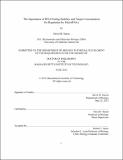| dc.contributor.advisor | David P. Bartel. | en_US |
| dc.contributor.author | Garcia, David M | en_US |
| dc.contributor.other | Massachusetts Institute of Technology. Dept. of Biology. | en_US |
| dc.date.accessioned | 2012-09-13T18:52:18Z | |
| dc.date.available | 2012-09-13T18:52:18Z | |
| dc.date.copyright | 2012 | en_US |
| dc.date.issued | 2012 | en_US |
| dc.identifier.uri | http://hdl.handle.net/1721.1/72803 | |
| dc.description | Thesis (Ph. D.)--Massachusetts Institute of Technology, Dept. of Biology, 2012. | en_US |
| dc.description | Vita. Cataloged from PDF version of thesis. | en_US |
| dc.description | Includes bibliographical references. | en_US |
| dc.description.abstract | Regulation of gene expression in eukaryotes is highly precise and complex. Changes in expression can define the fate of each cell, convert healthy tissues to diseased ones, and even lead to speciation. Regulation occurs at the steps of transcription, mRNA processing and stability, and translation. In the last decade, the scope of post-transcriptional regulation has been dramatically widened through uncovering widespread small RNAs as critical regulators of gene expression in eukaryotes. MicroRNAs (miRNAs) compose a major class of small regulatory RNAs. They are ~22-nt in length and bind to complementary sites in messenger RNAs to direct their degradation and translational repression. A central question for uncovering the biological roles of miRNAs is to understand how they find their target mRNAs, and a decade of work has highlighted one feature as most critical: base pairing between the 5' end of the miRNA and a complementary site usually located in the 3' UTR. One particular miRNA from the model organism Caenorhabditis elegans, called lsy-6, had in earlier studies not followed this principal, as most complementary sites were not repressed, which both intrigued and confounded the field. This thesis presents studies of lsy-6 targeting, conducted in human cell lines using heterologous reporter assays, which uncovered the reasons for this miRNA's generally poor targeting proficiency. These reasons are the weak pairing stability between lsy-6 and a target site in an mRNA, as well as the high number of endogenous mRNAs lsy-6 can bind to. Through a collaboration, the importance of RNA pairing stability and target concentration for miRNA targeting was extended to other miRNAs and siRNAs. Besides reconciling the unusual targeting behavior of isy-6 with the widely accepted model of miRNA targeting, these results also further suggest a mechanism of repression of its in vivo targets that is more complex than for most other miRNAs. | en_US |
| dc.description.statementofresponsibility | by David M. Garcia. | en_US |
| dc.format.extent | 135 p. | en_US |
| dc.language.iso | eng | en_US |
| dc.publisher | Massachusetts Institute of Technology | en_US |
| dc.rights | M.I.T. theses are protected by
copyright. They may be viewed from this source for any purpose, but
reproduction or distribution in any format is prohibited without written
permission. See provided URL for inquiries about permission. | en_US |
| dc.rights.uri | http://dspace.mit.edu/handle/1721.1/7582 | en_US |
| dc.subject | Biology. | en_US |
| dc.title | The Importance of RNA Pairing Stability and Target Concentration for Regulation by MicroRNAs | en_US |
| dc.type | Thesis | en_US |
| dc.description.degree | Ph.D. | en_US |
| dc.contributor.department | Massachusetts Institute of Technology. Department of Biology | |
| dc.identifier.oclc | 805948446 | en_US |
